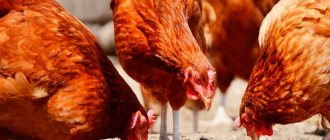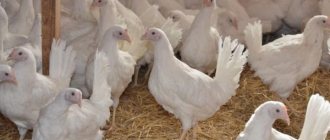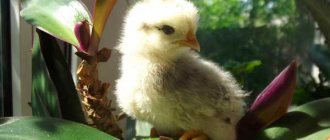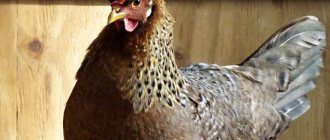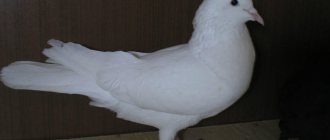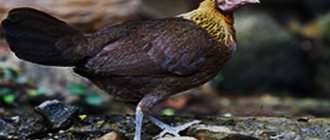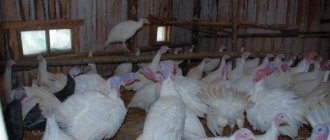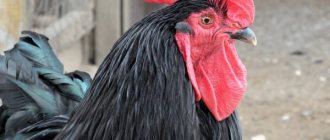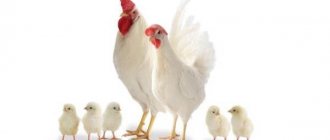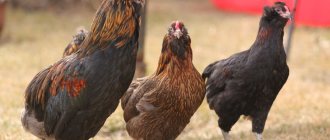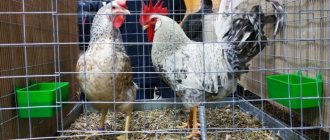- low temperature and high humidity can quickly lead to the development of diseases;
- this breed prefers spacious chicken coops and needs an aviary;
- their soft character also has a downside: these chickens are very shy;
- the fertility of chickens directly depends on their purebred, which is not very convenient when keeping different breeds together;
- Having laid eggs, the chicken completely loses interest in them, so to breed the Minorka, you have to place its eggs under other breeds or use an incubator.
Minorca chicken breed (Menorquina)
The homeland of the Minorca is Spain (Minorca). The breed originated from local black chickens. Breeders rejected individuals that did not meet the set standards, so today Minorca chickens are distinguished by high performance. Later, Minorca came to Great Britain, where local breeders improved its external qualities. It was in Great Britain that the chickens of this cross were given the name Minorca.
The homeland of the Minorca is Spain (Minorca)
Minorcas quickly spread throughout the world. Today the breed is valued not only by European, but also by American farmers, who believe that the cross fully pays for its maintenance even in winter. First of all, high-quality, large eggs are obtained from poultry, but they are also distinguished by the good taste of the meat.
Interesting!
Minorca chickens belong to the egg breed, but since English breeders made these birds larger and more massive, the meat quality of the bird is also excellent.
In Russia, Ukraine, Belarus, the minorka appeared in 1885. The breed in these countries is considered purebred because the birds were not given blood from other breeds. Most often, they are bred on private farmsteads, and large poultry farms keep them not so much for production, but as valuable genetic material.
Breeding history
Minorca chickens are named after the island of Menorca, located in Spain. There, farmers crossed several types of black chickens, obtaining this breed. In 1708, the island was captured by Anglo-Dutch troops, who appreciated the work of Spanish farmers.
Therefore, several chickens were transported to Albion, and their breeding continued. In 1780, a ban was imposed on the export of this breed to England. But by the end of the 19th century, chickens were firmly established in Great Britain, where they were called “Barbezier”.
In the 1870s, the breed appeared in Germany, 15 years later - in the USA and Russia. It is noteworthy that the chicken was presented to the Russians as a gift by the Sultan of Turkey. It was only in 1911 that the first domestic standard was developed, which determined the characteristics of the new breed.
Description of the breed
Also check out these articles
- The best eggplant caviar recipes
- Description and characteristics of the laying hen incubator
- How to properly keep Vietnamese piglets
- Barley varieties
Currently, there are three subspecies of Minorca, each of which has its own distinctive characteristics.
The head is small and beautiful, the crest and earrings are scarlet, the lobes are white, the eyes are coffee or black.
- The Black Minor is a typical representative of the Spanish species. The average weight of a male is 3 kg, a female is 2.5 kg. The body is elongated, but trapezoidal. The chest is round. The wings are developed. Legs are strong and high. The tail of males stands straight, while that of chickens is inclined to one side. The neck is elongated. The head is small but beautiful. The comb is leaf-shaped, scarlet, with 4-6 teeth. The earrings are scarlet and quite long. The earlobes are white and round. The beak is black, but the tip of the beak may be light. The face is red, without feathers. The eyes are coffee or black. The feather is bright black with a green tint.
- White Minorca - British standard. Chickens weigh 2.8-3.5 kg, roosters - 3.3-4 kg. The leaf comb (sometimes in the shape of a rose), scarlet, with curves, is well developed. The feather color can only be white with a silver tint. The bird's eyes are reddish. The beak, claws, and metatarsals are light, but a pink tint is possible.
- Dwarf Minorca . The description of the breed is the same as in previous cases. The only difference between this bird is its size. The average weight of a chicken is 800 g, a rooster is 1 kg. The bird's eggs are small, but their taste is the same as that of black or white minnows.
Interesting!
Dwarf Minorca chickens were bred in Germany. Today they are often bred as decorative ones.
Diseases
If the population of Minorok chickens lives in improper conditions, then the following health problems are possible:
- infection by infectious diseases;
- colds;
- frostbite of the comb and earrings;
- parasite infection.
- Parasites
- Infectious
- Other
Chicken mite
How to treat a chicken coop and how to treat a bird. Description of drugs and methods of control
Read
Coccidiosis
Thirst, loss of appetite, swelling, bloody droppings, anemia, weakness, poor coordination
Read
Ascariasis
Loss of appetite, liquid droppings, pale mucous membranes of the comb, limbs, ruffled plumage, lethargy, vomiting
Read
Amidostomiasis
Symptoms of the acute form: apathy, general weakness, decreased or lack of appetite, breathing problems, unsteady gait, retarded growth and development
Read
Prostagonymosis
Decreased mobility, loss of appetite, unsteady gait, bloating, fever, impaired egg laying, exhaustion
Read
Knemidocoptic mange (“lime foot”)
Acute symptoms: light gray bumps appear on the legs, the bird limps and stands on one leg, the cloaca and joints become inflamed, the beak is deformed
Read
Heteracidosis
Symptoms: indigestion, diarrhea, loss of appetite, lethargy, decreased egg production, retarded growth and development
Read
Trichomoniasis
Symptoms of the acute form: fever, depression and loss of appetite, diarrhea with gas bubbles and a putrid odor, enlarged goiter, difficulty breathing and swallowing
Read
Pullorosis (typhoid fever, salmonellosis)
Weakness, lack of coordination, drooping eyelids, difficulty breathing, lack of appetite, indigestion
Read
Colibacillosis
Lack of appetite, thirst, sudden increase in temperature, pale scallops, diarrhea
Read
Pasteurellosis
Fever, foamy mucus, change in stool color, refusal to feed, thirst, lethargy, wheezing, heavy breathing
Read
Marek's disease
Paralysis of the limbs, difficulty breathing, severe exhaustion and loss of strength, refusal of food and water, pallor of the scallop
Read
Gumboro disease
Diarrhea, loss of appetite, trembling legs and head, sudden death
Read
Laryngotracheitis
Weakness, swelling of the neck, difficulty breathing, cough, wheezing, blood clots in the mucus released when coughing, lack of appetite, indigestion
Read
Bird flu
Refusal to eat, anorexia, diarrhea, purulent discharge, hoarse breathing, greenish-brown droppings, seizures, darkening of the ridge
Read
Newcastle disease
Decreased appetite, fever, respiratory distress, immobility, conjunctivitis, bloody diarrhea
Read
Apteriosis
Complete or partial absence of plumage, loss of tail feathers, broken embryonic fuzz in young animals, delayed growth of plumage, pecking
Read
Pterophagy
Plucking and eating feathers. What is the reason, why does it require urgent intervention and how to prevent the disease?
Read
Yolk peritonitis
Symptoms of the acute form: loss of appetite, gray-green color of feces, sudden drop in egg production, calcareous deposits on the shell, bluish tint and baldness of the abdominal skin
Read
Cloacite
Symptoms: depressed state, decreased appetite, weight loss, increased need for water, loss of plumage, inflammation and bulging of the cloaca, the presence of ulcers on the mucous membrane, decreased egg production
Read
Signs of marriage of the Minorca breed
Only a purebred Minorka can produce many eggs, so it is important to know which traits do not match the breed. Below are the appearance features for which minors are rejected.
- A narrow torso, a flat back, or any abnormal bulges on the body;
- Chickens have an erect comb, while roosters have a drooping comb;
- Gray skin on the face;
- Unusual comb shape (too large or short, without rounding to the back of the head);
- A light-colored beak or red eyes in black minors, as well as a yellow beak and dark eyes in white chickens;
Deviations from the color, any spots and blotches on the feathers are signs of a defective Minorca breed
Important!
Minorca chickens are very shy. Usually they do not have contact with their owner, but they get along well with other breeds of chickens.
- Deviations from the color (light feathers for black birds, brown for white birds), any spots and blotches on the feathers;
- Short or dull feathers on adults.
When purchasing birds for breeding, it is important to carefully inspect each individual, as mixed breeds are very common. If you want to definitely buy a purebred flock, then it is best to order birds or fertilized eggs for an incubator abroad, at specialized poultry farms.
Breeding and caring for Minorka chicks
Since Minorcas come from countries with a mild and warm climate, they have a hard time with frosts; the birds are not adapted to them, so breeding offspring can only be done in heated rooms.
When breeding minorkas, owners are faced with one problem - the complete absence of the instinct to hatch in chickens, so the eggs must be selected and placed in an incubator.
Important! For breeding offspring, only eggs from hens that have been laying eggs for a second year or more are used.
After birth, chicks must be kept warm in an incubator until they are 5 months old. However, if the chick is notable for its liveliness and has quickly passed adolescence (the period of egg production has arrived in chickens or the comb of a rooster has begun to grow), it can be sent to a common chicken coop earlier.
Be sure to read:
Chickens of the Wyandotte breed - decorative appearance and excellent productivity.
Chickens up to 5 months should be fed boiled eggs, ground grains, chopped herbs and vegetables, gradually introducing food into the menu.
Productivity of Minorca chickens
We recommend reading our other articles
- Hyacinth flower
- The best blue grape varieties with descriptions and photos
- Description and characteristics of the Cinderella incubator
- Apricot Triumph northern
How good are Minorca chickens? To understand this, you need to become familiar with their productive qualities.
- Females begin to lay their first eggs at five months of age. But males are ready to fertilize eggs from the moment the crest grows.
- The egg production of one chicken reaches 200 eggs per year.
- Eggs with a white, smooth shell. The average weight of an egg is 75 g.
- Birds grow at a moderate pace. The weight of individuals depends on the subspecies, but usually the rooster grows up to 3.5 kg, and the female up to 2.8 kg.
- The poultry meat is quite tasty, the fibers are white and tender.
- Survival rate of young animals is 97%.
The bird is very beautiful, bright and is often bred as an ornamental
Important!
Unlike most egg breeds of chickens, Minorcas lay eggs not only in the warm season, but also in winter!
Well, of course, we must not forget that the bird itself is very beautiful, bright and is often bred as an ornamental bird. This is a definite bonus for every farmer.
Minuses
Birds are very thermophilic, and very sensitive to dampness, winds and other natural phenomena. It is best to breed Minorca chickens in a warm climate zone, or at least in the middle zone. They are not suitable for the northern regions and Siberia.
Birds are shy and have difficulty adapting to a new environment. It is also better not to change their diet radically, but if necessary, simply gradually replace one food with another.
Chickens of this breed are bad mothers and will not hatch eggs. In addition, birds may not only fail to hatch, but even peck at the eggs. Therefore, if you want to breed chickens, you will have to get an incubator.
It will also be useful to find out whether a chicken can lay eggs without a rooster.
Features of the breed
Since the historical homeland of the Minor is a country with a warm climate, these birds do not cope well with dampness and cold. Therefore, in cold regions you will have to spend money on comfortable conditions. The minimum permissible temperature in which they can be is +8 degrees. If the chicken coop is damp or cold in winter, Minorca chickens will begin to get sick, egg production will decrease and they will be of no use. So the chicken coop must be heated if the temperature outside can drop significantly.
The minimum permissible temperature in Minorca is +8 degrees
The chicken coop is built spacious so that there are no more than 5 chickens per square meter. The chicken coop should have not only artificial light, but also natural light. Drafts are excluded, but there must be ventilation. The inside of the chicken coop is arranged according to the usual pattern. There are enough perches, nests for chickens, feeders and waterers.
In the summer, birds should have a spacious aviary for walking. You can sow wheat, clover, and alfalfa inside so that the birds, if desired, will peck them. It is also worth installing a drinking bowl in the enclosure. A rain canopy is placed over one part of the enclosure. And the enclosure itself should be fenced with a fence about 1.5 m high.
Important!
If winters are harsh, and birds are sometimes allowed outside, you need to lubricate their combs with Vaseline to prevent frostbite.
Advantages and disadvantages of the breed
The main advantages of the breed, of course, are fertility. They begin to lay eggs early, from 5 months. They are large and nutritious. Laying hens produce eggs all year round. The meat is white and quite tasty. And in the yard they do not quarrel with other birds. The chicks are born quite strong and develop quickly. They have a good preservation rate.
Among the shortcomings, one can emphasize her caution, timidity and reluctance to communicate with people. Also in winter they are very afraid of the cold. And it’s hard to call them good mothers. Since this is an artificially bred breed, they do not have maternal instinct. Chicks have to be raised in incubators.
Feeding Minorca
Minorca chickens are not picky about their diet. They can be fed simply with compound feed or given grain mixtures, mash of vegetables, and herbs. Among vegetables, these birds can eat carrots, beets, potatoes, cabbage, lettuce, cucumbers, pumpkin, zucchini, etc. It is very important to add mineral supplements to the food such as meat and bone meal, yeast, and salt. In winter, premixes are added to food to prevent diseases.
Minorok can be fed with compound feed or given grain mixtures, mash of vegetables, herbs
In addition to the feeders, a bowl with fine gravel, sand, crushed shells and chalk is installed in the chicken coop. This mixture improves the birds' digestion. The water is changed 2 times a day. It should always be available to the birds. Any type of drinking bowl can be used, but it is important to ensure that they are always clean, as are the feeders.
Important!
Wet mash quickly sours in feeders in the summer when it is hot, so chickens should eat the mash in no more than 30 minutes. Leftover food is thrown away or refrigerated until the next feeding.
Description and characteristics with photos
Since these chickens are so popular and on everyone's lips, it is worth learning more about their exterior features, temperament and productive qualities. Russian farmers prefer to breed white Leghorns, although the color options in the breed are varied. The feathers of birds are brown, black, golden-fiery, smoky blue. The variegated colors are no less attractive.
Birds exterior
The external features of the representatives of this breed indicate their belonging to the egg production direction. This is evidenced by the small body size, dry constitution, and thin paws.
- the weight of a rooster ranges from 2.5 to 2.7 kg, of a chicken – 1.8–2 kg;
- small wedge-shaped body;
- paws of medium length, thin;
- The chest area is wide, rounded;
- back straight;
- neck elongated;
- the head is compact with a large leaf-shaped crest, which in laying hens falls to the side;
- earlobes white;
- earrings are colored red and are medium in size;
- red beard;
- The eye color of young individuals is orange, the iris becomes lighter with age;
- the metatarsals are yellow, but over time they become light and acquire a bluish tint;
- small yellow beak;
- the tail of the male is raised, the tail of the female is lowered;
- The feather structure is dense.
Temperament
According to farmers, Leghorn chickens have a peaceful disposition. There are no conflicts in chicken coops if the birds live in good conditions. Representatives of this breed are characterized by activity - they move a lot and love to walk in the fresh air.
Leghorn chickens
Productivity indicators
American breeders, who worked to improve the new breed bred by the Italians, set themselves two goals - to increase egg production and accelerate the maturation of birds. They managed to do both - the Leghorn hen is capable of producing about 300 eggs annually, and the egg-laying process in representatives of this breed begins at 4.5 months.
The weight of a Leghorn egg is 60–65 g. The shell is highly durable and painted white. This breed has a fairly high fertility rate of 95%.
Breeding the Menorquina breed
Minorca chickens do not have maternal instinct, so a brooder and incubator are used for breeding. Hatching eggs should be taken from females that are already 2 years old. As an option, you can use eggs obtained from minors to plant a chicken of a different breed, with a strong maternal instinct, then you can do without an incubator.
Minorca chickens do not have maternal instinct, so a brooder and incubator are used for breeding
Young animals need to be fed in the same way as any other chickens. At first it is a mixture of cottage cheese and eggs, then gradually add greens, steamed porridge, and pureed vegetables. If you have the means, you can feed the young animals with mixed feed. When the birds grow up, they are transferred to dry grain and transplanted from the brooder to adult birds.
Features of raising chickens
As mentioned above, “Spanish women” do not have a pronounced maternal instinct, so incubators or hens of other breeds are used to hatch chickens.
Breeding and rearing of Minor chickens occurs according to the following scheme:
- For breeding offspring, eggs are used only from hens that meet the breed standard and lay eggs for the second year.
- Medium-sized testicles are selected and stored for 3–5 days at a temperature of 12 to 18 °C with blunt tips facing up.
- Before placing in the incubator, eggs are kept for 2 hours at room temperature.
- The appearance of chicks should be expected on the 21st–23rd day after laying the material.
- Care for young animals is standard: warm housing (a box with high sides and a heated bottom to maintain a temperature of +30 ° C); nutritious and balanced food; fresh and clean drink; lighting with a lamp (from 6 a.m. to 8 p.m.); clean bedding that needs to be changed several times a day.
Feeding minorka chicks is no different from feeding ordinary chickens, so their diet should contain the following food:
- on the first day they give mashed eggs mixed with semolina;
- every other day you need to give cottage cheese;
- on the second day, finely chopped greens are added (young nettle, alfalfa, clover; a little later - dill, green onions, lettuce, sorrel);
- on the third day vegetables are introduced;
- from the 10th day you can add boiled root vegetables and crushed grains;
- as they fledge, high-quality nutrition with vitamins and minerals is added to the diet (ready-made feed for young animals);
- at 2 months, the offspring are transferred to adult food with the addition of bran, yeast mixtures, and meat and bone meal.
As the young animals grow, they undergo breeding selection, which includes the following parameters:
- general development;
- egg production - in hens at 5 months;
- exterior - in cockerels, as the comb grows.
Important! To renew the flock, chicken breeders recommend exchanging breeding material from other poultry farmers.
Reviews from farmers about the Minorca chicken breed
Beginning farmers are often interested in the experience of farmers who have already tried the breed in maintenance. Below are reviews from experts.
- Evgenia Mozgovaya : “I’ve been breeding black Minorkas for 3 years now. Very beautiful chickens, bright, produce a lot of eggs. I get about 190 eggs from a laying hen per year. They are tasty and quite large. I feed them regular grain mash and vegetables; in the summer they graze outside, but even in winter the feed consumption is not high, so it’s profitable to keep them. Some of the eggs are for sale and they are quickly sold out.”
- Veronika Pikalova : “I love Minorok chickens. This is probably the best breed for breeding! We keep both white and black minoras. White ones are larger, their meat resembles that of broilers. Black ones give more eggs - 200 pieces each. It takes a season from a chicken. I feed with mixed feed and grains, mash, I try to diversify the food so that there is enough of all the nutrients.”
- Olga Kuksova : “Minorcas are considered southern birds, I heard many times that they do not survive in cold regions, but I still decided to buy them for testing. Our summer and spring are warm, winter comes early and the frost is severe. But Minor cats tolerate it quite well, as it turns out! I keep them in the chicken coop in winter at +8...+10 degrees, I heat them with a simple heater (the chicken coop is insulated). At this temperature, they not only feel good, as it turned out, but also lay decently!”
Reviews
Let's find out what farmers who directly raise them say about Minorca birds.
- Valentina, 47 years old, Podolsk: “I have a private house with a large yard, so I’ve been keeping chickens for a long time: five years, exactly. The Minorca breed is one of the first that I got. Although I was warned about the demanding nature of the bird, I can’t say that I put a lot of effort into caring for them. Of course, my chicken coop is insulated, but the diet is normal. Birds grow quickly, they have very tasty meat, and in addition they also have large eggs. It seems to me that breeding this breed is a completely feasible task in an insulated, spacious room.
- Oleg, 39 years old, Saratov : “I saw the Minorca breed at an exhibition: all three species were presented there. I bought Spanish and English in pairs - they get along well together. Now they have already multiplied - the livestock is much larger. The downside is that an incubator is needed, since my chickens did not want to sit on eggs. Therefore, I learned that this is typical for all birds of this breed. It’s easy to feed them: I use regular feed and sometimes add vitamins. In summer they like fresh grass, grains. Productivity is high: I raise poultry both for meat and for egg production. The profitability is high, and the birds themselves are very beautiful.”
So, we looked at the features of the wonderful decorative and productive breed of Minorca chickens. As you can see, these birds really have something to boast about in terms of egg production and quality meat characteristics. In addition, with just their appearance, these chickens can make a poultry yard brighter and more picturesque. In our other articles you can read the description of Loman Brown chicken.
